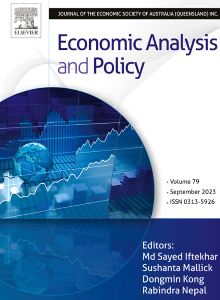Cross-border e-commerce and carbon emission reduction: A quasi-natural experiment based on the establishment of cross-border e-commerce comprehensive pilot zones
IF 8.7
2区 经济学
Q1 ECONOMICS
引用次数: 0
Abstract
Cross-border e-commerce, as a novel form of trade in the digital economy era, represents a critical pathway for advancing low-carbon development in the economy and society. This research adopts China's cross-border e-commerce comprehensive pilot zone (CEPZ) as a quasi-natural experiment. It applies a multi-period DID model and city statistical data, customs import-export data, as well as national tax survey data to systematically investigate the impact of the CEPZ policy on the reduction of carbon emissions. The research findings reveal that the establishment of the CEPZs significantly promotes carbon emissions reduction in both cities and enterprises. Furthermore, the promotional effect of the CEPZs on carbon emissions reduction exhibits substantial heterogeneity. At the urban level, CEPZs primarily facilitate the reduction of carbon emissions in areas characterized by well-developed digital infrastructure, inland regions, and non-traditional industrial cities. At the enterprise level, the CEPZs favor carbon emissions reduction in enterprises with high carbon intensity and low market competition. Mechanism analysis underscores that the CEPZs play a crucial role in driving carbon emissions reduction through three mechanisms, including the producer services agglomeration effects, industrial digitalization effects, and resource allocation optimization effects. Further analysis indicates that although the CEPZs generate significant positive spillover effects on carbon emissions reduction in neighboring enterprises, they do not propel carbon emissions reduction in adjacent cities. The conclusions offer empirical evidence and policy insights to align the development of new trade formats with low-carbon socioeconomic transitions.
跨境电商与碳减排:基于跨境电商综合试验区建设的准自然实验
跨境电子商务作为数字经济时代的一种新型贸易形式,是推动经济社会低碳发展的重要途径。本研究采用中国跨境电子商务综合试验区(CEPZ)作为准自然实验。运用多期DID模型,结合城市统计数据、海关进出口数据以及全国税务调查数据,系统考察了CEPZ政策对碳减排的影响。研究结果表明,cepz的建立对城市和企业的碳减排都有显著的促进作用。此外,cepz对碳减排的促进作用也存在较大的异质性。在城市层面,cepz主要促进数字基础设施发达地区、内陆地区和非传统工业城市的碳减排。在企业层面,cepz有利于碳强度高、市场竞争力低的企业进行碳减排。机制分析表明,cepz通过生产性服务业集聚效应、产业数字化效应和资源优化配置效应三种机制对碳减排起着至关重要的推动作用。进一步分析表明,cepz对周边企业的碳减排具有显著的正向溢出效应,但对周边城市的碳减排并无推动作用。这些结论为使新贸易形式的发展与低碳社会经济转型保持一致提供了经验证据和政策见解。
本文章由计算机程序翻译,如有差异,请以英文原文为准。
求助全文
约1分钟内获得全文
求助全文
来源期刊

Economic Analysis and Policy
ECONOMICS-
CiteScore
9.80
自引率
9.20%
发文量
231
审稿时长
93 days
期刊介绍:
Economic Analysis and Policy (established 1970) publishes articles from all branches of economics with a particular focus on research, theoretical and applied, which has strong policy relevance. The journal also publishes survey articles and empirical replications on key policy issues. Authors are expected to highlight the main insights in a non-technical introduction and in the conclusion.
 求助内容:
求助内容: 应助结果提醒方式:
应助结果提醒方式:


